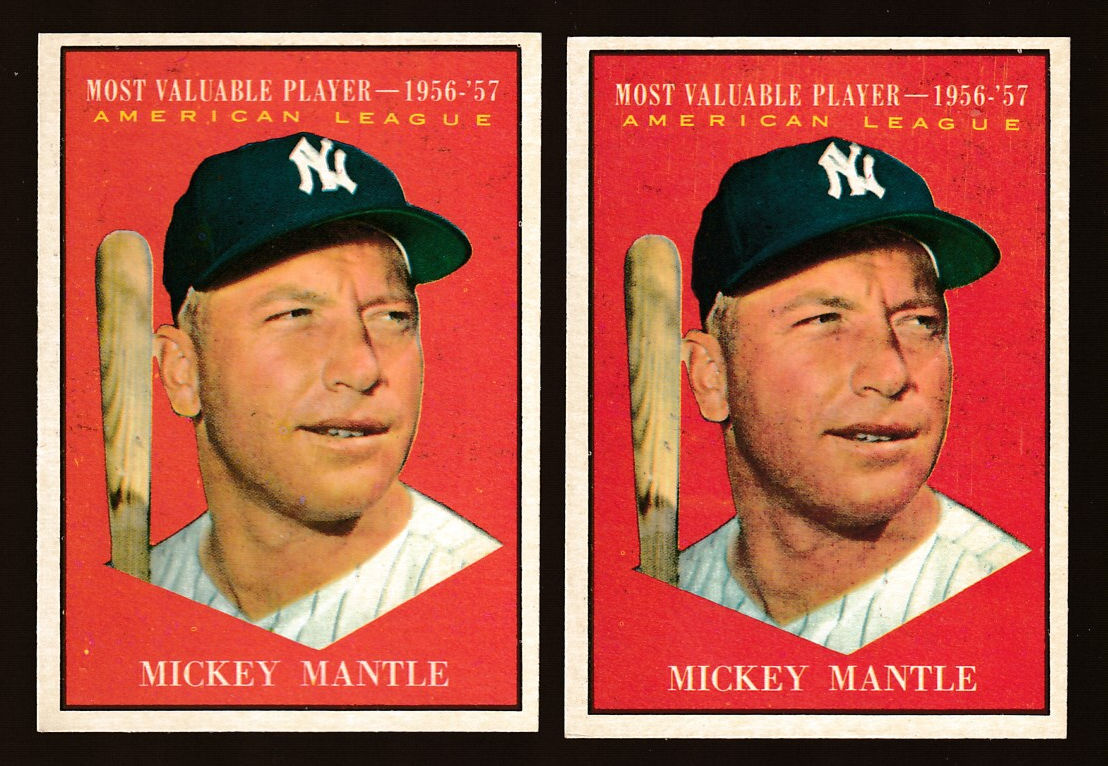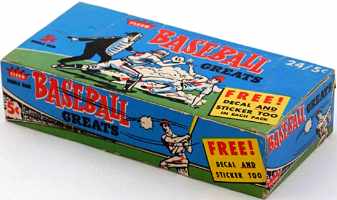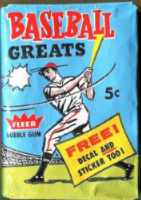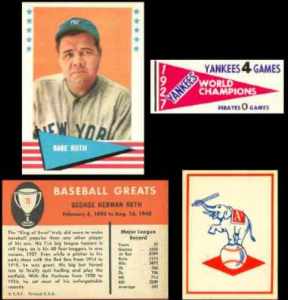1961 Topps #475 Mickey Mantle MVP (Yankees)
| Grade |
NM/MINT |
| Book Value |
n/a |
| Our Price |
$ 495
Add to cart
|


Below are short bits & pieces on sportscard & baseball trading card collecting.
Please wander around the website for more info, prices, values & images
on vintage baseball, football, basketball, hockey, sport and non-sports cards.
1954 Topps Baseball Cards
Checklist & Values
No only did the 1954 Topps issue feature the rookie cards of some of the
greatest baseball players of all-time, it also was the 1st appearance of
Ted Williams on a Topps card. Topps was so proud of this they made
Ted the FIRST (#1) and LAST (#250) card in the set.
1954 Topps was released in three different series, (#1-50),
a tougher mid-series (#51-75), and finally (#76-250). Of note for fans
of variations, first series cards were issued in Canada with gray backs.
ROOKIE cards of future Hall of Famers Hank Aaron, Al Kaline & Ernie Banks
along with cards of SuperStars Ted Williams, Willie Mays, Duke Snider,
Yogi Berra, Whitey Ford, Jackie Robinson and tons more !!!
Note: You may be on that page now.
|

1961 Fleer Baseball Cards


The 1961 Fleer baseball set contained 154 regular-sized cards
honoring careers of Hall-of-Famers Babe Ruth, Walter Johnson,
Lou Gehrig, Honus Wagner, Ted Williams and many lesser
known old-timers.
Released in 2 series, the 2nd series cards #89-#154 are somewhat
tougher to find.
Fleer was prevented from using current players by Topps'
exclusive rights, so they issued their Baseball Greats set using
retired players, managers, executives and the two league
commissioners. Luckily Fleer had their own exclusive rights deal
with Ted Williams, who quickly became the most in demand card in
the set.
 Unfortunately the weak card design and retired players made it a
giant dud with kids and the product was not well received.
Unfortunately the weak card design and retired players made it a
giant dud with kids and the product was not well received.
Cards were sold in five-cent packs and packaged with two special
inserts; a logo team decal and team pennant sticker of past World Series
champions.
Click for complete
1961 Fleer Baseball Cards
Note: You may be on that page right now.
|

1952 Topps Baseball Cards
Checklist & Values
1952 is often thought of as Topps 1st baseball card set, but it was not.
Topps issued several smaller baseball card sets prior to their huge 1952 set.
The buzz word at Topps back then was "BIGGER is BETTER" for their 1952 Topps set
which Topps described as: "GIANT IN BOTH SIZE and NUMBER of CARDS" (407).
Key card in the 1952 Topps set is #311 MICKEY MANTLE.
Often called Mickey Mantle's Rookie card - BUT IT IS NOT. That honor
goes to his 1951 Bowman.
1952 Topps "High Numbers" (#311-#407), are very, very scarce with an
interesting story:
This HUGE set was released in series, released weeks apart. By the last
series, baseball was over and football starting.
??? Perhaps the set was too huge ???
Shops had cards left from earlier in the year so many orders
were cancelled, thus the scarcity.
Adding interest is how Topps got rid of the now useless cards, including
THOUSANDS of MICKEY MANTLE's. They dumped them into the Ocean !!!
|

Tobacco Cards
Starting approximately in 1886, sportscards, mostly baseball cards, were often
included with tobacco products, for promotional purposes and also because the
card reinforced the packaging and protected cigarettes from damage. These sports
cards are referred to as tobacco cards in the baseball card hobby. Over the next
few years many different companies produced baseball cards. Tobacco cards soon
started to disappear as the American Tobacco Company tried to develop a monopoly
by buying out other companies.
They were reintroduced in the 1900s, as American Tobacco came under pressure from
antitrust action and Turkish competition. The most famous and most expensive,
baseball card is the rare T206 Honus Wagner. The card exists in very limited
quantities compared to others of its type because Wagner forced the card to be
removed from printing. It is widely (and incorrectly) believed that Wagner did
so because he refused to promote tobacco, but the true explanation lies in a
dispute over compensation.
Soon other companies also began producing baseball and football cards. Sports magazines
such as The Sporting News were early entries to the market. Candy manufacturers
soon joined the fray and reflected a shift toward a younger target audience for cards.
Caramel companies were particularly active and baseball cards were one of the first
prizes to be included in Cracker Jacks. World War I soon suppressed baseball card
production.






 The 1961 Fleer baseball set contained 154 regular-sized cards
honoring careers of Hall-of-Famers Babe Ruth, Walter Johnson,
Lou Gehrig, Honus Wagner, Ted Williams and many lesser
known old-timers.
The 1961 Fleer baseball set contained 154 regular-sized cards
honoring careers of Hall-of-Famers Babe Ruth, Walter Johnson,
Lou Gehrig, Honus Wagner, Ted Williams and many lesser
known old-timers.  Unfortunately the weak card design and retired players made it a
giant dud with kids and the product was not well received.
Unfortunately the weak card design and retired players made it a
giant dud with kids and the product was not well received. 